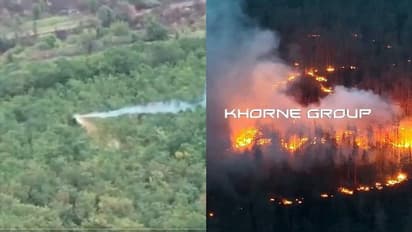Ukraine unleashes 'dragon drones' dropping molten metal on Russian forces in escalating conflict (WATCH)

Synopsis
Ukraine has introduced "dragon drones" in its conflict with Russia, which drop molten metal on enemy positions using thermite, a substance that reaches 4,000°F (2,200°C). Videos show the drones releasing fiery torrents, igniting vegetation and leaving no cover for Russian troops, marking a new and devastating tactic in the ongoing war.
Ukraine has reportedly unleashed a new and devastating weapon in its ongoing conflict with Russian forces – a fleet of fire-breathing drones that rain molten metal on enemy positions. Dubbed "dragon drones," these weapons are equipped with thermite, an incendiary substance capable of reaching temperatures as high as 4,000 degrees Fahrenheit (2,200 degrees Celsius).
Videos circulating on social media, including one posted by the Ukrainian defense ministry on Telegram, show the drones swooping low over Russian-held positions, releasing torrents of molten metal that ignite trees and vegetation, providing no cover for Russian troops.
Thermite, a mixture of aluminum powder and iron oxide, has been used in warfare for over a century. Its ability to burn through almost any material, including metal, makes it a particularly lethal tool on the battlefield.
According to a report by CNN, the Ukrainian military is using the drones to target areas where Russian forces are entrenched in wooded areas, setting the landscape ablaze and leaving troops vulnerable to the intense heat and flames.
The deployment of thermite is not new in warfare. The substance was first used by Germany during World War I, when it was dropped from zeppelins over Britain. During World War II, both the Germans and the Allies employed thermite in aerial bombs, using it to devastating effect. The substance was also used to disable artillery by placing thermite inside the breech of captured weapons, effectively melting them from the inside out.
While thermite is just one of many incendiary weapons, it remains one of the most potent. Incendiary weapons, which also include napalm and white phosphorus, are designed to ignite and cause widespread destruction by fire. As thermite burns at such high temperatures, it can easily destroy anything it comes into contact with, making it extremely difficult for soldiers to defend against or escape its effects.
The use of incendiary weapons has long raised concerns in international humanitarian law. According to the United Nations Office for Disarmament Affairs (UNODA), incendiary weapons are designed to cause burn injuries, destruction, and respiratory harm through the action of extreme heat and flames. The unpredictable and often uncontrollable nature of the fires they create makes them dangerous not only to combatants but also to civilians and the environment.
UNODA stresses that the use of such weapons is closely regulated under international law to prevent superfluous injury or unnecessary suffering. However, despite these concerns, incendiary weapons continue to be employed in modern warfare due to their effectiveness in disabling enemy forces and equipment.
While the use of thermite dates back to early 20th-century conflicts, it has remained relevant in modern military arsenals. The U.S. military, for instance, has used thermite in grenades and other munitions. From the 1960s through 2014, the US Army’s Pine Bluff Arsenal produced thermite grenades, resuming production again in 2023.
Thermite’s ability to destroy equipment and structures, combined with its destructive capabilities against enemy forces, has made it a go-to option for militaries around the world. In the context of Ukraine’s conflict with Russia, the deployment of thermite-laden drones marks a significant escalation in the use of incendiary weapons on the modern battlefield.
Check the Breaking News Today and Latest News from across India and around the world. Stay updated with the latest World News and global developments from politics to economy and current affairs. Get in-depth coverage of China News, Europe News, Pakistan News, and South Asia News, along with top headlines from the UK and US. Follow expert analysis, international trends, and breaking updates from around the globe. Download the Asianet News Official App from the Android Play Store and iPhone App Store for accurate and timely news updates anytime, anywhere.